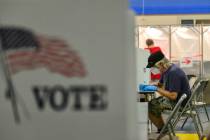What might have been
In 2009, even before President Barack Obama took office, he met with leaders of the House and Senate to discuss a massive stimulus package to rescue the economy from a devastating recession. The package would include tax cuts, but also spending on infrastructure.
What it would not include, however, was relief for homeowners whose home values had been submerged by the tanking economy. "We will not roll out an aggressive housing plan," Obama told the assembled leaders, according to Bob Woodward's new book, "The Price of Politics."
That assessment is buttressed by an Aug. 19 New York Times story by Binyamin Appelbaum, which contrasts the president's strenuous efforts during his first two years in office to stabilize the financial system, save the automobile industry from bankruptcy and pass the stimulus with his cautious approach to housing. The administration ultimately left unspent more than $300 billion that Congress had set aside to buy mortgage loans.
"The nation's painfully slow pace of growth is now the primary threat to Mr. Obama's bid for a second term," the Times story reads. "And some economists and political allies say the cautious response to the housing crisis was the administration's most significant mistake."
If so, Obama and his surrogates have tried hard to correct it.
On Friday, San Antonio Mayor Julian Castro joined local Democrats - former Rep. Dina Titus, state Sen. Steven Horsford and Assemblywoman Lucy Flores - to outline some of the other programs used by the administration to help struggling homeowners, from mortgage modification to a nationwide legal settlement with banks, all aimed at keeping people in their homes. Those programs include the Home Affordable Refinance Program (HARP), which helps people current on their mortgage get refinancing at better rates, and the Home Affordable Modification Program (HAMP), which aims to help homeowners make their existing mortgage more affordable. Together, officials said, those programs together have helped more than 2.5 million stay in their homes.
Still, Nevada struggles. The website RealtyTrac estimated that 1 of every 402 housing units in Nevada was in foreclosure in August.
Could things have been different if President Obama had acted more quickly to address housing, rather than focus on other priorities in 2009? What impact would spending billions buying troubled mortgages have had on the economy? Could it even have happened, given Republican resistance to additional spending?
"President Obama is the only one out there, as opposed to the Congress, who has put forward a significant effort," Castro said Friday. "I believe that the president has pushed hard on this issue."
All the Democratic officials also took delight in pointing out Republican nominee Mitt Romney's remark to the Review-Journal editorial board in October that the key to fixing the housing crisis is to let the foreclosure market "hit the bottom." But if a person can no longer afford a home, isn't the free-market reality that they should lose it in favor of an owner who can?
Flores says no, especially in light of the culpability of some banks that practiced predatory lending, or loaned money to applicants whom they knew could not repay the loans. "No, you can't just let something hit rock bottom and suffer," said Flores.
But the bottom line is, despite the many programs available, despite the millions spent, many Nevadans are still suffering in the housing crisis, and some homes will never be worth what their owners paid for them. Whether that could have been different with stronger, swifter action in 2009 we will never know.
Steve Sebelius is a Review-Journal political columnist and author of the blog SlashPolitics.com. Follow him on Twitter (@SteveSebelius) or reach him at (702) 387-5276 or ssebelius@reviewjournal.com.

















